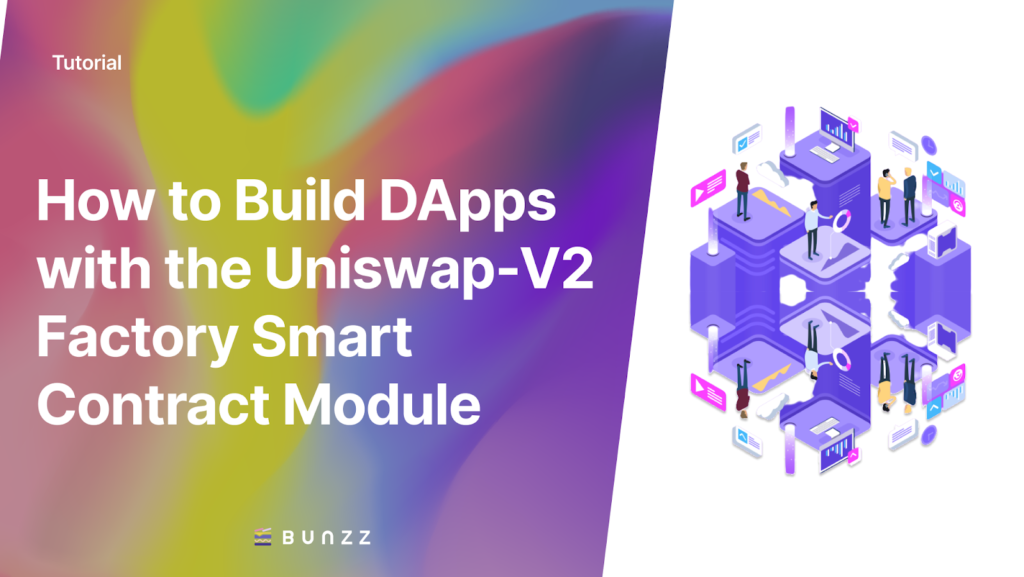Decentralized applications (DApps) have revolutionized how we interact with blockchain technology, bringing transparency, security, and autonomy to various industries. Among the most prominent DApps in the Ethereum ecosystem is Uniswap, a decentralized exchange protocol that enables seamless token trading and liquidity provision.
The recently released Uniswap V2 Factory contract module on the Bunzz smart contract hub allows developers to unlock a world of possibilities, empowering them to build innovative DApps that facilitate trustless and efficient token swaps.
In this blog post, we will explore the Uniswap V2 Factory contract module in-depth and delve into the process of building DApps on top of it. Whether you are a blockchain enthusiast, an aspiring developer, or an entrepreneur looking to leverage the immense potential of decentralized finance (DeFi), this guide will provide you with the knowledge and tools to kickstart your journey into the world of DApp development with Uniswap V2.
How does the Uniswap V2 Factory work?
Uniswap V2 Factory is a smart contract deployed on the Ethereum blockchain. It is part of the Uniswap decentralized exchange protocol and serves as the factory contract for creating new instances of Uniswap V2 exchanges.
The Uniswap V2 Factory contract is responsible for deploying and managing the individual exchange contracts that facilitate the trading of ERC20 tokens. It provides a template for creating new decentralized exchanges and enables users to list and trade tokens on the Uniswap platform.
Users who want to create a new exchange on Uniswap V2 interact with the Uniswap V2 Factory contract by calling the `createPair` function. This function takes two ERC20 token addresses as parameters and deploys a new Uniswap V2 exchange contract specific to those tokens. The exchange contract represents the market for trading the two tokens and contains the logic for token swaps, liquidity provision, and price calculations.
The Uniswap V2 Factory contract also keeps track of all the created exchanges by mapping token pairs to their corresponding exchange addresses. This mapping allows users to discover and interact with existing exchanges easily.
It’s important to note that the Uniswap V2 Factory contract is specific to the second version of Uniswap. Subsequent versions, such as Uniswap V3, have been released, which introduced additional features and improvements.
The “getPair” and “createPair” functions
The `getPair` function is a method provided by the Uniswap V2 Factory contract. It is used to retrieve the address of the exchange contract associated with a specific token pair.
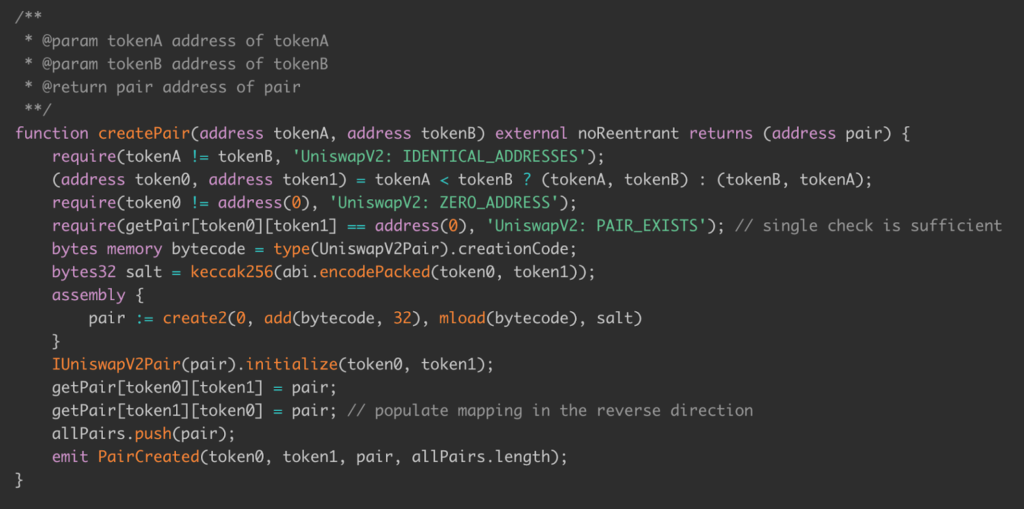
When a new Uniswap exchange is created using the Uniswap V2 Factory contract’s `createPair` function, a unique exchange contract is deployed for that token pair. The `getPair` function allows you to obtain the address of this exchange contract by providing the addresses of the two tokens involved in the pair.
Once you have the exchange contract address, you can interact with it to perform various actions such as token swaps, liquidity provision, or fetching the current token prices.
Note that the `getPair` function is specific to the Uniswap V2 Factory contract and may have different implementations in other versions of Uniswap or similar decentralized exchange protocols.
The “FeeTo” and “FeeToSetter” functions
In the context of Uniswap V2, the `feeTo` address and `feeToSetter` functions are part of the Uniswap V2 Factory contract. They are used to manage fee settings for the decentralized exchanges created by the factory.
1. `feeTo`: The `feeTo` address is a variable in the Uniswap V2 Factory contract that determines where the trading fees collected by the Uniswap exchanges should be sent. By setting the `feeTo` address, the protocol can specify where a portion of the trading fees generated by the exchanges should be directed.

Typically, the `feeTo` address is set to a designated address controlled by the Uniswap protocol or associated governance mechanism. By directing a portion of the trading fees to this address, the protocol can use the funds for various purposes, such as funding development, liquidity incentives, or other ecosystem-related initiatives.
2. `feeToSetter`: The `feeToSetter` function is used to set the address with permission to update the `feeTo` address. Only the `feeToSetter` address is allowed to modify the `feeTo` address, ensuring that changes to the fee recipient can be controlled and authorized by the protocol.

It’s worth noting that the fee structure and fee percentages in Uniswap V2 can vary depending on the liquidity provider’s choice and the specific implementation of the exchange contract. These functions provide flexibility for configuring and managing fee settings within the Uniswap ecosystem.
6 DApp Ideas with the UniswapV2Factory Module
The Uniswap V2 Factory smart contract provides the foundation for building decentralized applications (DApps) that involve token trading and liquidity provision. Here are some examples of DApps you can build using the UniswapV2Factory contract:
1. Decentralized Exchange Interface: You can build a user-friendly interface that allows users to discover and trade ERC20 tokens on the Uniswap platform. Users can connect their wallets, view token pairs, check prices, and execute token swaps directly through your DApp.
2. Token Listing Service: Create a DApp that allows token projects to list their tokens on Uniswap. Users can submit their token details, and your DApp can interact with the Uniswap V2 Factory contract to create new exchange contracts for the token pairs, enabling liquidity provision and trading.
3. Liquidity Management Tools: Develop tools enabling users to manage Uniswap liquidity. This can include features such as adding or removing liquidity from existing exchange contracts, calculating impermanent loss, tracking liquidity provider rewards, or providing analytics on liquidity pool performance.
4. Automated Market Maker Strategies: Build a DApp that implements sophisticated trading strategies using Uniswap. You can develop algorithms that automate token swaps based on specific conditions, such as price movements or liquidity pool imbalances. These strategies can be used for arbitrage, market-making, or portfolio rebalancing.
5. Yield Farming Platforms: Create a yield farming platform where users can stake their tokens in Uniswap liquidity pools and earn additional tokens as rewards. Your DApp can interact with Uniswap V2 Factory to deploy new liquidity pools, distribute rewards, and manage the staking and unstaking processes.
6. Token Swap Aggregator: Develop a DApp that aggregates liquidity and token swaps across multiple decentralized exchanges, including Uniswap. Users can get the best token swap rates by routing their trades through your DApp, which intelligently splits the trade across various liquidity sources.
These are just a few examples of the possibilities with the Uniswap V2 Factory smart contract. The flexibility and open nature of the Uniswap protocol provide developers with the opportunity to innovate and create various DApps that leverage decentralized token trading and liquidity provision.
Using the Uniswap-V2 Factory DApp Boilerplate
Building a DApp that implements Uniswap-V2 Factory can be a complex process, but with the help of the Bunzz boilerplate, it can be made much easier.
Let’s walk through the steps of using the Bunzz boilerplate, which provides a pre-written codebase that can be easily customized to meet your specific needs, allowing you to save time, test, and deploy your DApp quickly.
The Uniswap V2 Factory DApp boilerplate was built using the following:
- React.js for the Front-End and user interface
- UniswapV2 Factory smart contract module deployed from Bunzz
- Web3.js and ethers.js interact with the smart contract.
- Binance Smart Chain (BSC) Testnet
Here are key steps to ensure you have everything needed to run and customize the boilerplate for your use case:
- Clone the GitHub repository of the Uniswap V2 boilerplate to your local computer.
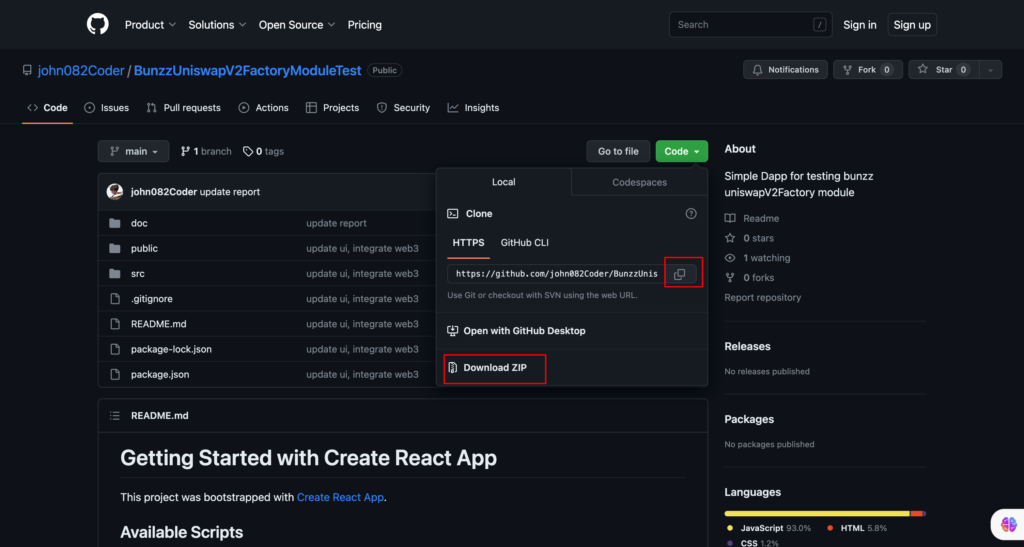
- Open the cloned repository using your preferred IDE, such as Visual Studio Code.
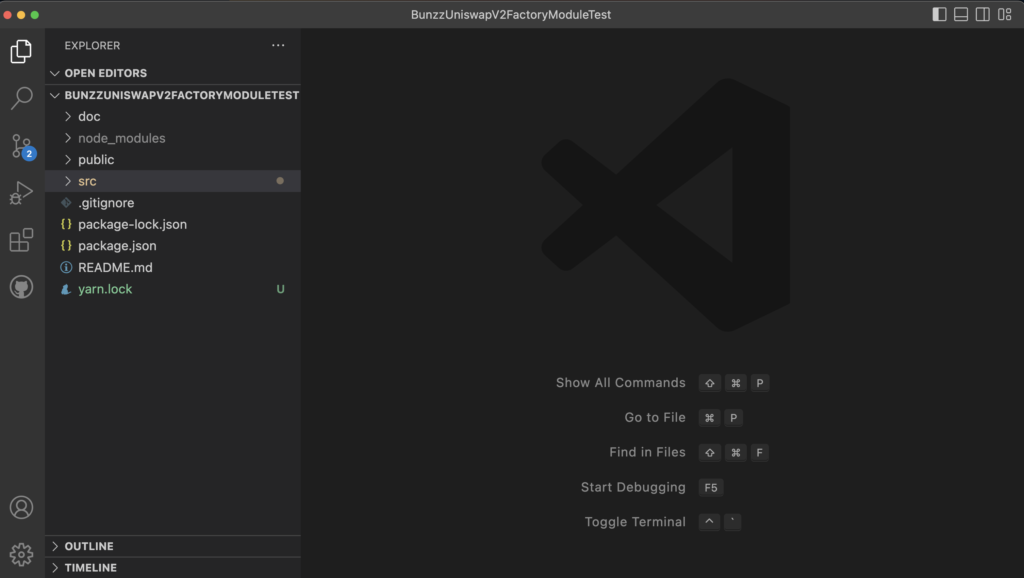
- Install the necessary NPM packages by running npm install or yarn install in the terminal.
- Deploy the Uniswap-V2 Factory smart contract module from the Bunzz dashboard

- Copy the ABI and smart contract address from the Bunzz dashboard after deployment.
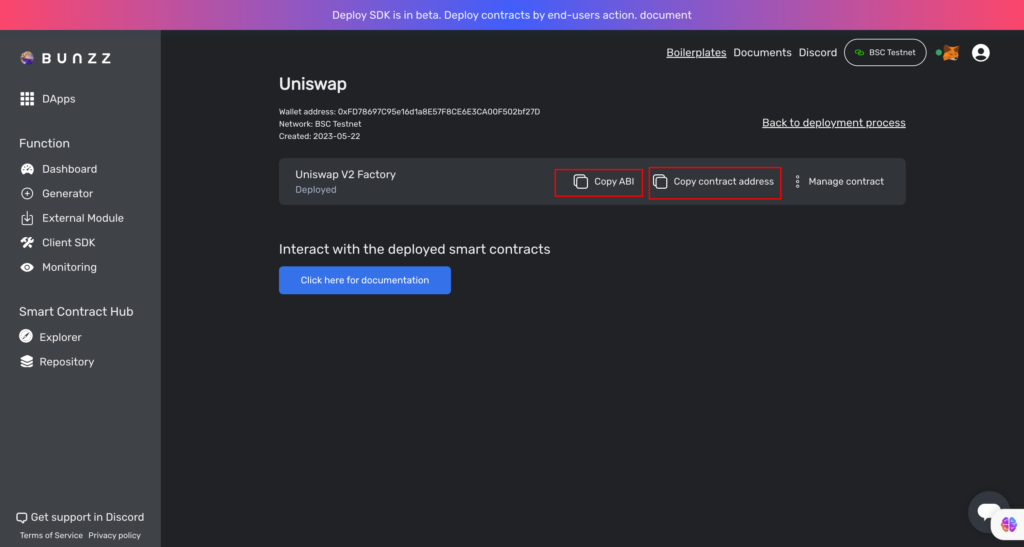
- Open the uniswapV2Factory.json file and replace the existing ABI content with the one you copied from the Bunzz dashboard. Do the same for the erc20.json file (deploy an erc20 token, copy ABI and replace the existing file with it)
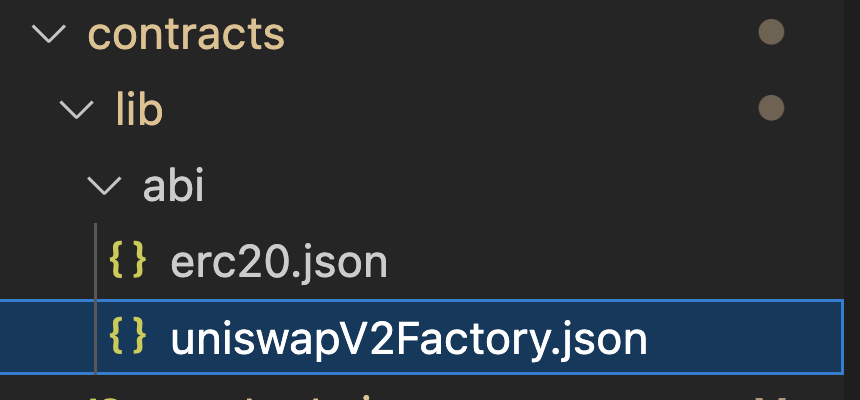
- Open the constants.js file and locate the smart contract address variable. Replace the current address with the one you copied from the Bunzz dashboard.
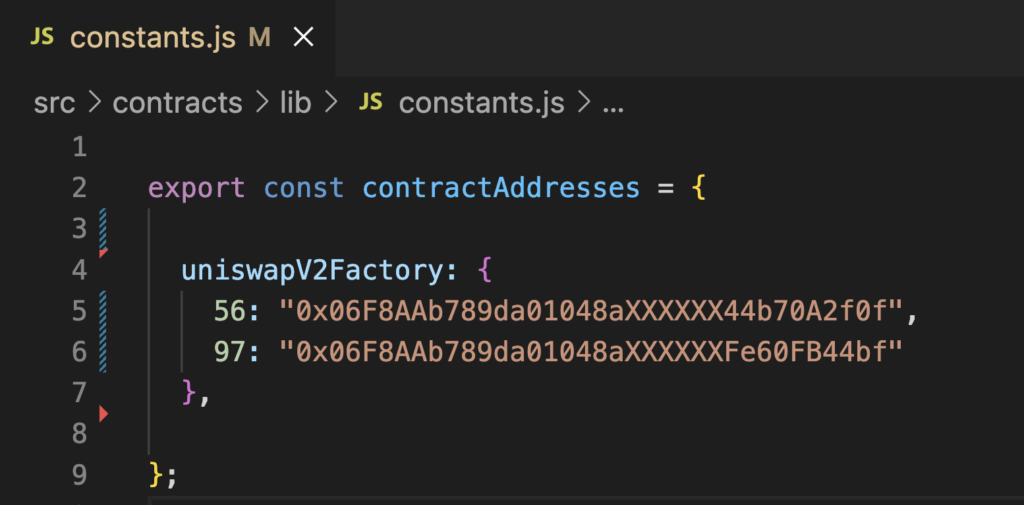
- Start the app by running npm start or yarn start. The DApp will look exactly like the image below.

You can change the interface or add new features by editing and customizing the boilerplate code to fit your Uniswap-V2 use case.
Interacting with the DApp
- Connect Wallet
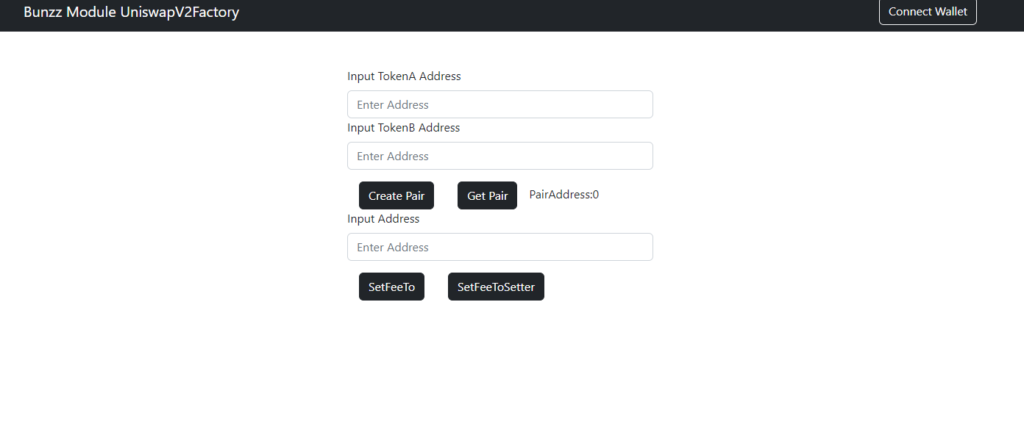
You should connect your wallet by clicking connect wallet button at the top right of the screen.
- Create pair

Create pair by clicking Create Pair button. You have to input the addresses of TokenA and TokenB.
- Get pair address

Get any ERC20 pair address by inputting TokenA address and TokenB address, and then clicking the Get Pair button.
- Change FeeTo address and FeeToSetter address

Change feeTo address by clicking SetFeeTo button and inputting address. You can also change setter address by clicking SetFeeToSetter button.
——————
Following these steps and using the boilerplate will give you everything you need to build and customize a Uniswap Factory V2 contract for your use case.
We can’t wait to see what you’ll build; if you follow these steps and get stuck or have any questions, feel free to reach out on Discord or send a DM on Twitter.
